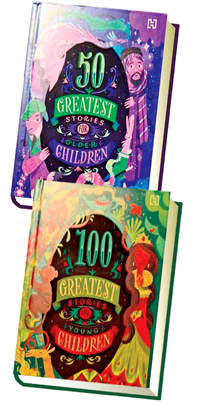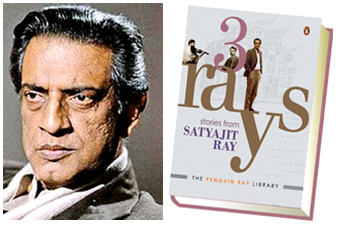“100 Greatest Stories for Young Children” and “50 Greatest Short Stories for Older Children”
 By Various (Author)
By Various (Author)
Published by
Hachette India
“100 Greatest Stories for Young Children” and “50 Greatest Short Stories for Older Children” are two volumes of children’s literature. These are collections with a mix of the oft anthologised folk tales, short stories and extracts in the English Literature canon but also some of the well-known stories from India or rather, mostly Bengal. Truly loads of fun! Just the kinds of books one relishes reading, recollecting favourite stories read in the past and sharing with the next generation. The emotions created at remembering them are as strong as when first encountered.
In a way, these are the best-loved tales, by the best storytellers ever! A bear who loves honey, an awesomely clever bunny, a mean giant who turns nice, nimble deer and mice, a magical man who helps, genies and elves, friends who’ve got your back, clucks and quacks, a throne with secret powers, a pot that cooks for hours, eggs of gold, courtiers bold, a tail on fire, a really bad liar, wishing trees and, of course, princesses and peas... These are only a few of the things you will read about in this super collection of the most favourite stories ever. Selections from the works of Beatrix Potter and Enid Blyton, Hans Christian Andersen and the Grimm Brothers, R.K. Narayan and Oscar Wilde - besides a pick of the top tales from the Ramayana, Mahabharata, and Panchatantra, the Jatakas, the Kathasaritasagara and other classics - are all in here. That’s why this big fat treasury of old and new fun adventures, fairy tales, fables, folklore and more is perfect whenever you want to explore the world of great stories and storytelling, anytime, every time.
Some of the authors of the stories that are included here are Aesop, Anna Sewell, Beatrix Potter, Charles Dickens, Edith Nesbit, Enid Blyton, Flora Annie Steel, Grimm Brothers, Hans Christian Andersen, Johanna Spyri, L. Frank Baum, Lewis Carroll, Margery Williams, Mark Twain, Oscar Wilde, R.K. Narayan, Rudyard Kipling, Robert Browning, Somadeva, Sukumar Ray and Upendrakishore Ray Chowdhury.
This is an excellent attempt at correcting the material with examples of Indian literature but it is inexplicable why the editors chose to represent India as the land of Hindus and Buddhists with the inclusion of more than one story from the epics and the Jataka Tales while ignoring all the other faiths that are an intrinsic part of this magnificently multi-cultural country. However, there are no editors mentioned anywhere in the books.
“Locking Down the Poor:
The Pandemic and India’s Moral Centre”
 By Harsh Mander
By Harsh Mander
Published by
Speaking Tiger Books
This is a most demanding book on the issues of India’s COVID-19 pandemic. We all know that pandemic is affecting India very badly and relentlessly. The author describes all the aspects of it.
He explains that India is a home to the largest number of undernourished people on the planet. In spite of that, India imposed the world’s harshest lockdown for the pandemic. Yes, India is a country that has not been releasing data on health and nutrition since 2014, publishes no reliable figures on urban daily-wagers, and was already in its worst crisis of unemployment since Independence, now pushed the poor to the edge of death.
In “Locking Down the Poor: The Pandemic and India’s Moral Centre,” Harsh Mander collates fact after damning fact from this period, along with many individual stories, showing how state institutions stripped India’s poor of their political rights and dignity, and emptied the republic of any moral content.
He says in the book: “The central and state governments offered no relief of any kind to the workers on the road. In fact, they did the opposite. When some senior IAS officers in Delhi organized buses for migrants who wanted to return, they were reprimanded, suspended and removed from their postings. Many migrant workers reported being beaten like fugitives from the law by the police. In mid-May, more than 500 migrant labourers from Bihar, Jharkhand, Odisha and other states were assaulted by police in Vijayawada.
They were returning from establishments that had shut down in Tamil Nadu and Andhra Pradesh when they were stopped on the highway by the Andhra police and told to go back. When the workers refused, the police resorted to a vicious lathi charge. ‘We will never return to AP again. Hundreds of workers are walking on the roads for more than a month and the officials did not even offer us a packet of biscuits. Instead of helping the poor, the police are beating us mercilessly,’ a woman labourer said.”
“Three Rays”
 By Satyajit Ray
By Satyajit Ray
Published by Penguin India
“Three Rays: Stories from Satyajit Ray” is the first book in ‘The Penguin Ray Library’ series which celebrate his centenary birth anniversary that falls on this year. With more than forty previously unpublished stories, autobiographical writings and illustrations by Ray are included in this volume.
The following poem is an excerpt from the book. It was originally published in Sandesh (January 1915 as Khichuri. Later, it was revised when published in the book “Abol Tabol” (U. Ray & Sons, 1923). The English translation by Satyajit Ray was published in “Nonsense Rhymes” by Sukumar Ray (Writers Workshop, India, 1970). The illustrations in the poem are by Sukumar Ray.
A duck once met a porcupine; they formed a corporation
Which called itself a Porcuduck (a beastly conjugation!).
A stork to a turtle said, ‘Let’s put my head upon your torso;
We who are so pretty now, as Stortle would be more so!
The lizard with the parrot’s head thought: Taking to the chilli
After years of eating worms is absolutely silly.
A prancing goat–one wonders why–was driven by a need
To bequeath its upper portion to a crawling centipede.
The giraffe with grasshopper’s limbs reflected: Why should I
Go for walks in grassy fields, now that I can fly?
The nice contented cow will doubtless get a frightful shock
On finding that its lower limbs belong to a fighting cock.
It’s obvious the Whalephant is not a happy notion:
The head goes for the jungle, while the tail turns to the ocean.
The lion’s lack of horns distressed him greatly, so
He teamed up with a deer-now watch his antlers grow!
Satyajit Ray (1921-1992), one of the greatest film-makers of our times, received the Oscar for Lifetime Achievement by the Academy of Motion Picture Arts and Sciences in 1992. In the same year he was honoured with the Bharat Ratna.
A polymath and a polyglot, Ray was not only an ace designer and but also a brilliant music composer and illustrator. His writings for children, young adults and adults continue to attract readers across the world.
